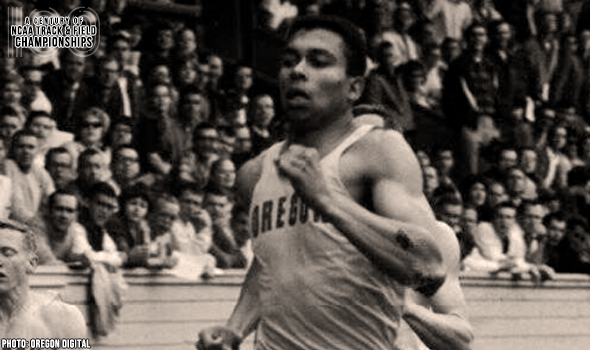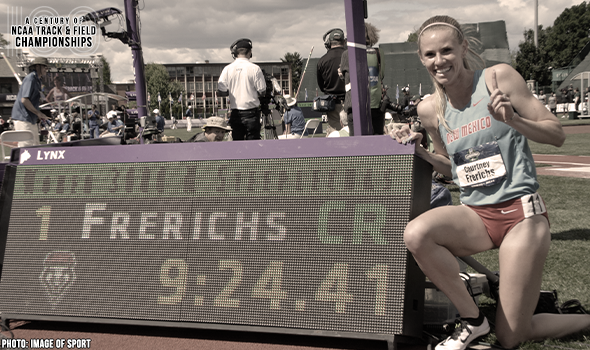
Oregon’s Jerome Sprinted To NCAA Glory
If ever a meet could have used photo-finish timing, it was the 1964 NCAA Outdoor Track & Field Championships.
The 5000 and 400 were both ruled deadlocks, but those were with merely two runners inseparable.
The 100-meter final saw three sprinters crossing the line at almost the same instant: Harry Jerome of Oregon, Edwin Roberts of North Carolina Central and Trenton Jackson of Illinois.
It took almost an hour to sort the finish, but when they did, Jerome was ruled the victor in 10.1. Roberts (second) and Jackson (third) were also credited with that same mark as well.
“Honestly, that’s one I’d hate to judge on,” Jerome said about the finish to Dick Leutzinger of the Eugene Register-Guard. “Usually I know when I win or lose. I’d hate to say on that one.”
While the 10.1 was a meet and collegiate record, it wasn’t a PR for Jerome. He still owned a share of the world record of 10.0 that he set in the summer after his freshman season back in 1960.
Jerome was a Canadian prodigy who came from great lineage. As a high school standout in North Vancouver, British Columbia, he broke a 31-year-old national record in the 220 yards. And many knew his grandfather, John Armstrong Howard, who was the first Black athlete to represent Canada in the Olympic Games.
The fact that Jerome was even running in 1964 – near his best, let alone at all – was a comeback story for the ages. Jerome tore his quadriceps tendon in the fall of 1962 at the British Commonwealth Games and the seriousness of the injury led many to believe that he would never run again. He didn’t believe that and a little over a year later, he opened the 1964 season by equaling the world indoor best in the 60-yard dash with his time of 6.0.
Then at the 1964 NCAA Championships, Jerome doubled back in the 200, taking third to lead Oregon to its second team title in three years – both at Hayward Field. The Ducks won their first national title in 1962 when Jerome won the 220 yards and was runner-up in the 100.
Not long after that, Jerome went to the Tokyo Olympic Games, where he earned his lone Olympic medal – a bronze in the 100.
Jerome died in 1982 of a brain aneurysm at age 42. In 1984, the Labatts Classic held in Burnaby was renamed the Harry Jerome Classic and in 1988 a statue of him was erected in Vancouver’s Stanley Park.
The NCAA and collegiate track & field will mark a momentous milestone in the spring of 2021 -- the 100th anniversary of the NCAA Championships and with that, the NCAA Track & Field Championships. In June 1921, the University of Chicago hosted the first track & field championships in NCAA history.
This point can’t be emphasized enough: Not only was the event the first for NCAA track & field, but the first championships for any sport under the sponsorship of the NCAA.
To celebrate, over each of the next 365 days, the U.S. Track & Field and Cross Country Coaches Association (USTFCCCA) will celebrate moments, student-athletes, and coaches that have made a century’s worth of championships special. From humble beginnings to important historical milestones to the modern-day, collegiate track & field has evolved with the American society.
The 2021 edition of the NCAA Division I Outdoor Track & Field Championships begin with preliminary round action on May 27-29 in Jacksonville, Fla., and College Station, Texas. The championships final site and culmination of the celebration is slated for June 9-12, 2021 at the newly rebuilt Hayward Field in Eugene, Ore.

Sternberg Reached New Heights In 1963
Brian Sternberg won the pole vault title at the 1963 NCAA Outdoor Track & Field Championships. He was the first athlete to clear 16 feet in meet history at 4.97m (16-3¾).

Williams Went Back-To-Back With CR In 1996
Tonya Williams won back-to-back 400H titles at the NCAA DI Outdoor T&F Championships in 1995 & 1996. She set a CR of 54.56 in 1996 & won by 0.35 seconds.

Kimobwa Ran Into Record Book In 1977
Samson Kimobwa set a MR in the 10K of 28:10.27 at the 1977 NCAA DI Outdoor T&F Championships. He won by 12.21 seconds in a race that saw the top-2 finishers under previous meet record.

Florida’s Taylor Set All-Conditions TJ Best In 2011
Christian Taylor set an all-conditions meet best in the triple jump of 17.80m (58-4¾) at the 2011 NCAA DI Outdoor T&F Championships. Taylor also won the TJ crown in 2010.

Johnson Led 1-2-3 HJ Sweep By Arizona In 1985
Katrena Johnson led a 1-2-3 finish by Arizona athletes in the high jump at the 1985 NCAA DI Outdoor T&F Championships. Johnson cleared 1.94m (6-4¼) to set a collegiate record.

Fresno State’s Robinson Equaled WR In 1957
Ancel Robinson equaled the world record in the 220H of 22.2 at the 1957 NCAA Outdoor T&F Championships. He also matched the American record & collegiate record.

Johnson Set 1500 MR After Thrilling Duel
Sinclaire Johnson set a meet record in the 1500 of 4:05.98 at the 2019 NCAA DI Outdoor T&F Championships. Johnson won an epic duel against Jessica Hull of Oregon.

Bohni Soared To Pole Vault MR In 1983
Felix Bohni set a meet record in the pole vault of 5.55m (18‑2½) at the 1983 NCAA DI Outdoor T&F Championships. Bohni was one of three men to top 18 feet.

Frerichs Broke Steeplechase Records In 2016
Courtney Frerichs set a collegiate record in the steeplechase of 9:24.41 at the 2016 NCAA DI Outdoor T&F Championships. Frerichs won by the second largest margin in meet history.

URI’s Black Rolled To NCAA’s 1st 10K Title
Robert Black won the first 10,000-meter title ever awarded at the NCAA Outdoor Track & Field Championships in 1948. Black crossed the finish line in 32:13.5, 48 seconds ahead of the runner-up.

